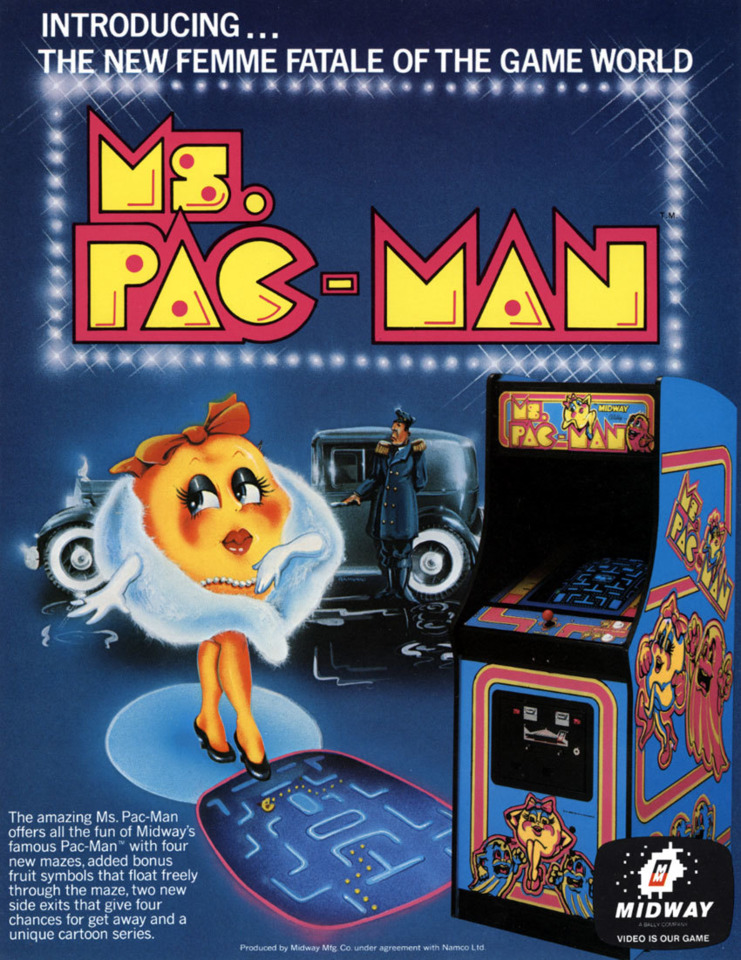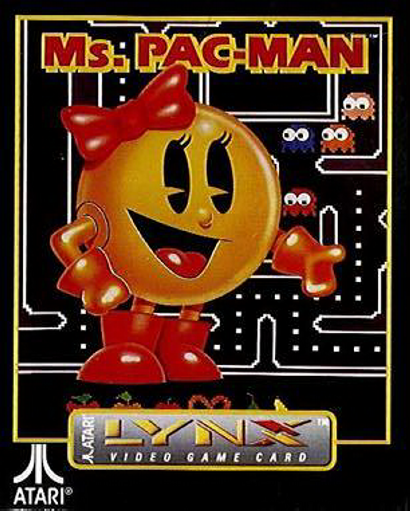NamCompendium 10: Ms. Pac-Man, Pt. 1
By jeffrud 0 Comments
(Editor's note: There's not a lot of excuses that can cover for as long a gap as the one there has been in this project, but death in the family is probably one of them. I have been helping my partner process the emotional and legal fallout of her father's passing, and this entry took a backseat for a while. It is now live on NamCompendium.com, and I decided that I might as well put out something a little shorter if it meant finishing it in the first place. Hopefully we'll be back to a normal pace soon enough.)
Ms. Pac-Man
3 February 1982 (Arcade, United States)
Well, here it is. The most bonkers NamCompendium entry yet, and one a long time coming. The looming presence of Ms. Pac-Man has cast a shadow on several prior entries in this project. We’ve seen many of the key players in this long and sordid players named already, and there are several thousand words available here and elsewhere on the impact of Pac-Man. That title was a true watershed release, one which has informed Namco (and now Bandai Namco) from that point forward. It was only natural that Namco saw the potential for sequels to follow on the success of Pac-Man, and we’ll be covering those down the line as well. But, as we shall see, they were beaten to the punch.

General Computer Corporation has already received high marks in the NamCompendium for their contract work under Atari. We first encountered them with their conversion of Namco’s Galaxian for the VCS, work that stemmed from the settlement between GCC and Atari over their development of unsanctioned Missile Attack clones. GCC did not develop every Namco conversion on Atari platforms, but when you consider that one of the major outliers was the Tod Frye developed 2600 port of Pac-Man, perhaps they should have just taken on each of these jobs. They also designed the Atari 5200 from the ground up amidst the division of Atari into Atari Games (now dead) and Atari Corporation (now Atari SA, TAFKA Infogrames, currently shilling a microconsole that seems not entirely above board). In so many words, Atari kept the upstart designers at GCC busy.
But then, they had been busy for many years prior to the 5200 debacle. There had been the Super Missile Attack project which drew the ire of Atari in the first place. There had also been another project by the name of Crazy Otto.
To frame Crazy Otto correctly, I must reiterate that the original arcade release of Pac-Man was famously bootlegged and remixed several times in the 1980s. Arcade operators accepted modified boards that would change the gameplay in subtle ways, with the aim of drawing more players into their doors. By far the most common of these was to increase the general speed of the game, but other changes altered ghost patterns and behaviors. Crazy Otto was born of this milieu, originally pitched by GCC to the officially sanctioned distributor of Namco’s Pac-Man for North America, Midway Games.
Depending on which source you are reading, any number of relationship permutations thereby occurred between GCC, Midway, and Namco. Doug Macrae of GCC has gone so far as to say that Nakamura Masaya himself approved of assets used in the final commercial release of Ms. Pac-Man. On the other hand, it seems that the game set a precedent whereby Midway felt more than happy to leverage the Namco licensed likeness of Pac-Man for a number of unsanctioned sequels to the original game. This would lead ultimately to the end of Namco’s distribution deal with Midway in the mid 1980s.
The specifics are murky, and tied up in a great deal of “he said, she said” that dates back to 1981. What is clear is that between the ingenious base designs of Iwatani Toru, the upstart programming moxie of Doug Macrae, and the marketing and distribution capabilities of Midway, there was potential for Ms. Pac-Man to be a special game even its most nucleic state.

Benj Edwards has helpfully fixed the original arcade release date of Ms. Pac-Man as 3 February, 1982. That date heralded the coming of one of the absolute greatest games of all time. Ms. Pac-Man surpasses the original Pac-Man in numerous ways, by my own estimation. The first thing the player may notice is the more complex maze layouts, now including two sets of warp tunnels per side. There are in fact four new mazes in Ms. Pac-Man (including one with single warp tunnel) that rotate every three or four levels. The fruits that spawned mid-level in Pac-Man OG now bounce through the mazes, forcing the player to make choices about whether or not they were worth pursuing. The look and sound of the game has been altered, with the maze walls drawn as solids rather than hollow barriers and new sound effects at every turn.
Most notably, the primary antagonists of the game have been overhauled. Whereas Pac-Man’s ghosts were governed by fixed AI-esque routines, Ms. Pac-Man now must content with pseudo-random behavior from the ghosts. True experts at the original game would no longer be able to rely on proven tactics to achieve their high scores, thereby (at least on paper) forcing then to pop in more quarters into this new machine.
There is also the matter of the game’s central figure. She may not fit a current working definition of the phrase, but Ms. Pac-Man is de facto gaming’s first Strong Female Character. She was capable of everything her male counterpart could do, and more. When you consider that she accomplished more or less the same work load as her husband (claim territory in a variety of mazes by eating all of the dots) faster and with a stronger opposition, you could fairly make the case that Ms. Pac-Man was in fact a stronger lead than her predecessor. And while it is difficult to cite actual numbers to support the notion that Ms. Pac-Man has the knock-on effect of attracting women into arcades, it is certainly the Ur instance of a game marketing directly towards a segment of the population not already targeted by existing products. Iwatani’s problematic “make a game about eating to attract women” concept for Pac-Man is set aside for a simpler one: “Why not let people play as a girl for once?” It doesn’t improve the game directly, but as an intangible “it” factor it has certainly helped to keep Ms. Pac-Man relevant.
And remain relevant it has. Ms. Pac-Man has a singular distribution history after its arcade release, with a freakishly long list of developers and publishers. At one point I had optimistically hoped that OG Pac-Man would be the most complicated installment in this series. Jeff makes plans, and Ms. Pac-Man laughs at them.
After the February 1982 release into American arcades (which mentions Nakamura Masaya by name in a “Hello” callout), there was a year’s wait before the Atari-contracted General Computer Corporation put forth their conversion of the game they developed for the venerable VCS. This was a three man job, as opposed to the solo effort on 2600 Pac-Man, and there is a marked improvement here. There is the stupid, slavish adherence to the “black backgrounds for space games” internal design principle within Atari, and the pervasive flickering on ghost sprites makes its unwelcome return. On closer examination, however, this is a superior conversion. There is an effort to recreate the Ms. Pac-Man maze layout here, including the double warp tunnels on either side. the player is now harried along by four ghosts as well. Bonus fruits bounce along as expected, with a decent little thud sound effect. The entire aural palette of the game is in fact vastly improved here, including a noble and not entirely unsuccessful rendition of the Ms. Pac-Man jingle. Both this and Pac-Man the First were outgunned by Alien, in my opinion, but this is a good start for Ms. Pac-Man on Atari platforms.
I say a good start, because we’re going to go for a hat trick and more here; Ms. Pac-Man’s first four home conversions (non-microcomputer division) landed on Atari platforms. The second of these, the 5200 conversion that arrived on store shelves in September 1983. The Pac-Man that was available at launch for this lame duck of a system was quite good, and this is just ever so slightly better on the strength of being a slightly better game on the whole. There’s also a little more detail here on the ghost sprites when compared to OG Pac-Man, which is precisely the sort of hair splitting this project was built to document. We even get rudimentary recreations of the “cutscenes” from the arcade game here! A fine conversion, one that hangs among the best arcade conversions on the 5200 platform.
Ms. Pac-Man turns up again during the June 1984 test launch of the Atari 7800, alongside the four other Namco titles developed by GCC for the console’s release. Like the rest of that ill-fated set, these wouldn’t see a full retail launch until mid-1986 after the Atari split (documented here). This is honestly a fantastic port. The aspect ratio of the mazes is preserved from the arcade original, the ghosts now leave behind score numbers when eaten, you get four mazes in rotation, and the cutscenes are touched up from the 5200 version. The whole thing also moves at a nice, frantic clip.
Of course, that’s not the only Ms. Pac-Man released on the system. Pac-Man Collection, released by Opcode Games in the late 2000s, also includes a conversion of Ms. Pac-Man for the system alongside the previously covered port of Pac-Man. Not bad at all by homebrew standards, the collection uses the more advanced POKEY sound hardware that the 7800 could utilize in lieu of its onboard 2600 sound. The Pac-Man conversion in this collection is solid, but the Ms. Pac-Man doesn’t quite hang compared to the official port. It’s just a bit choppy, and moves slower than the sanctioned release. Again, for a hobbyist piece it is hardly bad, and the plus of having both games and a slew of extras on one cartridge is a pretty big bonus. But if you want the best, get the original version.
We shall close this long overdue entry into the NamCompendium with a smoldering hot first: our inaugural coverage of the Atari Lynx. Much like how Commodore basically bought a new computer line when it licensed the Amiga, Atari Corporation partnered with (and eventually purchased outright in bankruptcy proceedings) Epyx. Their handheld hardware featured an ambidextrous design, a full color display, and a revision that included a compact fluorescent bulb as a backlight because what in the hell was wrong with these people are you kidding me.

Exact release dates for Lynx games are virtually non-existent, but thankfully the two titles we’ll cover on the Lynx were released in different calendar years and are therefore easily arranged chronologically. Ms. Pac-Man came to the Lynx in 1990. This port helpfully includes credits at the title screen, which allowed me to credit the developers in the Giant Bomb Wiki. As far as the game goes, it’s an incredibly shrill sounding port that feels like Ms. Pac-Man was squeezed onto a postage stamp. None of the scrolling maze nonsense from Game Boy Pac-Man here, you get the full maze on screen at all times. You also get the different maze layouts, cutscenes, and cores popping out of enemies and fruits. The ghost sprites are not as detailed as prior versions, but when you consider this ran on a 160×102 pixel screen it becomes understandable. This first portable version of Ms. Pac-Man would be unopposed for about three years, at which point it could be measured against Game Boy and Game Gear ports. Until then, just for not bothering with the awful scrolling viewport feature, this is fine.
We’ll be having a look at both of the aforementioned conversions next time. Stick around as well for about half a dozen developers having a crack at Ms. Pac-Man, including both versions released for the NES (hooray for Tengen!), our first fleeting glimpse of the CD-i, Ms. Pac-Man as the launch game for Xbox Live, and more! Ms. Pac-Man Part 2 is forthcoming, probably around 2048.
